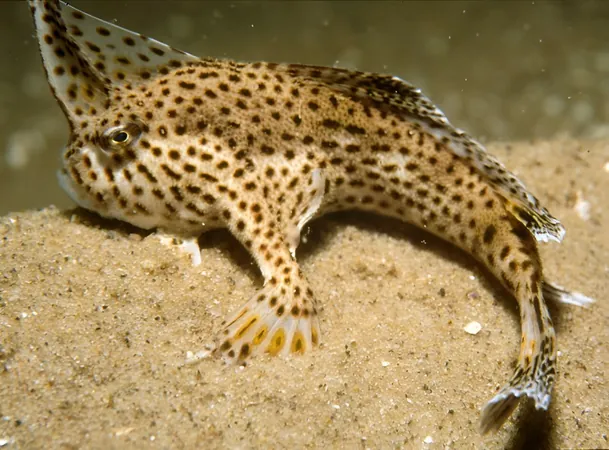
Breakthrough: First Genome of the Rarest Fish Revealed!
2024-10-08
Author: Li
In a groundbreaking scientific achievement, researchers from CSIRO, Australia's national science agency, have successfully sequenced the complete genome of the critically endangered spotted handfish (Brachionichthys hirsutus), a unique marine species found only in Tasmania. This remarkable milestone marks the first time the genome of this elusive fish has been mapped in its entirety, setting the stage for potential conservation efforts that could save it from extinction.
Once abundant along the southeast coast of Tasmania, the spotted handfish has seen its population drastically decline over the years. Officially designated as critically endangered in 1996, current estimates suggest that fewer than 2,000 individuals remain in the wild. The primary causes of this decline include unsustainable fishing practices, coastal development, the impact of climate change, and the introduction of invasive species.
The newly sequenced genome is envisioned as a vital tool for conservationists. Dr. Gunjan Pandey, a Senior Research Scientist at CSIRO, expressed the significance of this genomic breakthrough: “The genome offers profound insights into how this species operates biologically, paving the way for us to enhance our conservation strategies." He emphasized how the findings can assist in monitoring genetic diversity, estimating longevity, and improving species detection.
Carlie Devine, a Principal Investigator focused on the spotted handfish's conservation, noted that this wealth of genetic information will inform long-term strategies aimed at preserving the species. “Our approach is evolving to incorporate genetic data, recognizing that we need a holistic methodology that blends ecological research with genetics for effective conservation.”
Remarkably, the opportunity to sequence this genome emerged after a spontaneous death of a spotted handfish in a controlled environment, showcasing the challenges associated with studying marine organisms. Dr. Pandey highlighted the technical difficulties involved in working with such delicate specimens, as DNA from marine species is prone to rapid degradation and contamination.
Utilizing a specialized technique known as a low-input protocol, the researchers successfully extracted a high-quality genome from a small quantity of suboptimal DNA, a process carried out in partnership with the Biomolecular Resource Facility at the Australian National University. “We are part of a select group of just three teams worldwide employing this method,” Dr. Pandey added, showcasing the innovative adaptation of lab settings and bioinformatics to achieve this feat in just days rather than months.
CSIRO has been actively engaged in monitoring spotted handfish populations since 1997, focusing on nine localized groups within the Derwent Estuary. Their multifaceted conservation approach encompasses not only a captive breeding program but also avant-garde strategies for habitat restoration, aiming to stabilize and eventually increase the population numbers of this rare and vulnerable marine species.
As the threats against the spotted handfish continue, this genomic research represents a beacon of hope. It exemplifies how science and technology can come together to protect the planet's most endangered creatures, with the potential to revolutionize wildlife conservation efforts worldwide. Will the secrets of the spotted handfish's survival be unlocked through this genetic roadmap? Stay tuned!



 Brasil (PT)
Brasil (PT)
 Canada (EN)
Canada (EN)
 Chile (ES)
Chile (ES)
 España (ES)
España (ES)
 France (FR)
France (FR)
 Hong Kong (EN)
Hong Kong (EN)
 Italia (IT)
Italia (IT)
 日本 (JA)
日本 (JA)
 Magyarország (HU)
Magyarország (HU)
 Norge (NO)
Norge (NO)
 Polska (PL)
Polska (PL)
 Schweiz (DE)
Schweiz (DE)
 Singapore (EN)
Singapore (EN)
 Sverige (SV)
Sverige (SV)
 Suomi (FI)
Suomi (FI)
 Türkiye (TR)
Türkiye (TR)